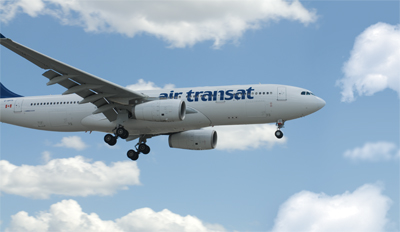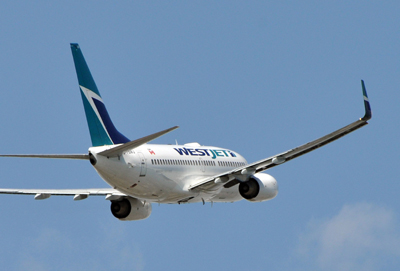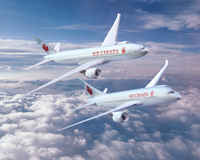
Features
Airlines
The Lines Are blurring
While the forecast has been gloomy for some players in the commercial aviation market the past few months, fortunes are brightening for Canadian carriers – especially in the leisure market.
November 3, 2010 By David Carr
While the forecast has been gloomy for some players in the commercial aviation market the past few months, fortunes are brightening for Canadian carriers – especially in the leisure market.
 |
|
| PHOTO: PETER LUBIG
|
Shifting trends in Canadian air transport are likely to continue to blur the distinction among the country’s front-line carriers, where Air Canada and WestJet have aggressively added capacity, and where Jazz, Canada’s third largest scheduled airline, is readying to enter the fray.
The Canadian leisure market demonstrated the greatest resiliency in 2010, as customers offset the financial crisis with fixed-price holiday packages that included low-cost hotels, car rentals and coach tours. Transat A.T.’s summer business was busy enough to absorb a 15 per cent increase in capacity between Canada and Europe. Transat is Canada’s largest holiday tour operator and owner of Air Transat, the country’s largest leisure airline, responsible for 50 per cent of its parent’s lift capacity. (Transat uses more than 60 airlines overall, including Canjet for southern destinations, Transavia for medium-haul flights from France, and Thomas Cook Airlines for long-haul transatlantic flights.)
A summer uptick for Transat was in sharp contrast to a dismal winter program, where the company posted an operating loss of $4 million – the first in its 24-year history – blamed in part on greater competition from non-traditional operators like Air Canada and WestJet, who had shifted an estimated 10 per cent of capacity to sun markets to compensate for lost business on scheduled domestic and transborder routes, and new Boeing 737 deliveries by WestJet.
This is all familiar terrain to Nelson Gentiletti, Transat’s chief operating officer, who told Wings that it is common for the larger network carriers to redeploy aircraft to the leisure side during a down cycle, only to have them exit the sector during the rebound.
For the Canadian airline industry, the rebound appears to have taken hold. According to the Conference Board of Canada, the Canadian airline sector will return to profitability in 2010 with pre-tax earnings of $192 million, a near $600-million turnaround from the combined $381-million loss in 2009.
 |
|
| WestJet’s growth strategy includes transborder expansion, a new frequent flier program and plans to reinsert itself into the busy Toronto/Montreal/Ottawa triangle. PHOTO: BRIAN MCNAIR |
Canada’s performance mirrors what is happening around the world, where more disciplined capacity management, rising demand – including the premium cabin – and lower operating costs have enabled the International Air Transport Association to revise its global 2010 profit forecast upward to $8.9 billion even as competition continues to put downward pressure on air fares.
But is the rebound strong enough to persuade scheduled airlines like Air Canada, which relies on the business traveller to drive its economic model, to make a speedy exit from the leisure market? It’s unlikely, at least for the immediate term, and not before 2012 as long as redeployment of the existing fleet is helping to grow revenue. It is even less likely for WestJet, which has a different business model from Air Canada, with a smaller transborder presence and no significant alliance.
For WestJet, sun destinations have emerged as a bright spot in a re-energized growth strategy that includes transborder expansion, a new frequent flier program to take on the Air Canada/Aeroplan Goliath and plans to reinsert itself into the busy Toronto/Montreal/Ottawa triangle, where it lags behind both Air Canada and upstart Porter Airlines.
WestJet, which has already stitched together a patchwork of alliance partnerships with airlines such as Cathay Pacific and Air France/KLM, in order to draw more international traffic away from Air Canada, continues to try to land a tie-up with a major U.S. airline to replace the collapsed negotiations with Southwest earlier this year. Speculation has centred on Delta Airlines (a member of the Skyteam Alliance with Air France, Korean Air and China South), following a deal by WestJet to purchase five Delta slots at New York’s La Guardia Airport. Delta’s merger with Northwest Airlines was finalized in January.
Jazz hits a new note
Also bullish on the leisure market as part of its growth and diversification strategy is Jazz, which signed a contract with Thomas Cook to operate six Boeing 757s on the tour operator’s behalf between Canada, the Caribbean, Mexico and Central America over the winter season.
The Thomas Cook deal is the second major point of departure the Air Canada feeder announced in 2010. Jazz’s previous leisure activity was limited to domestic charters – sports teams, fishing camps, etc. – using two Dash 8-300s. The earlier departure was a minority stake in Uruguay’s Pluna Airlines, with a complementary fleet of seven Bombardier CRJ900s, signed in April after analyzing other business opportunities in both Latin America and China.
Jazz took delivery of the first two 757s in November with the remaining four aircraft joining the fleet by Christmas. Similar to its Capacity Purchase Agreement (CPA) with Air Canada, Jazz will operate the aircraft, deliver the cabin service and manage flight and airport operations while Thomas Cook determines routes, flight schedules, creates ticket prices and handles marketing.
Joe Randell, Jazz chief executive officer, told Wings that the Pluna Airlines and Thomas Cook deals are part of the evolution of the company, which has launched an executive class cabin on its CRJ705 aircraft and has taken on more heavy flying on behalf of Air Canada, including flights on longer haul, thin routes such as Calgary-Houston. The Thomas Cook deal, for example, has turned the traditionally slow winter period into an operating peak. The 757s will be returned to Thomas Cook at the end of the winter, but Randell would not rule out extending its leisure business to the summer.
Transat follows the sun
Despite a disappointing winter season for 2010, Transat has great expectations for 2011 as consumer confidence gathers steam. Sun destinations account for 80 per cent of Transat’s business in the winter months compared with 20 per cent for the European schedule. (During the summer period those numbers can be reversed.) Transat expects global capacity to increase by 15 per cent in 2011, growth that is reflected by its own experience in markets such as the Caribbean. Even with added capacity by Air Canada and WestJet, Transat does not expect the aggressive price cuts of 2010.
For its part, Transat is trying to fill seats earlier by overhauling its pricing model to offer lower rates upfront. This strategy is a reversal from the standard industry practice of slashing prices closer to departure and is considered by analysts as a more effective way of controlling costs while filling seats sooner.
Transat is also taking a page out of its European program by offering segment fares to sun destinations. In the past, Transat’s traditional one- to two-week vacation packages have been driven by scheduling. By tapping into its broader airline network, such as Canjet, and pricing a round trip on the fare for each segment, Transat is matching the greater scheduling flexibility offered by Air Canada and WestJet and meeting growing demand for shorter holiday getaways.
Fleet renewal
Going forward, Air Transat continues to transition to an all long haul, wide-body fleet made up exclusively of Airbus A330s. The current mixed fleet consists of 13 A310s and five A330s. In September, Air Transat signed an agreement with CIT Aerospace for two additional 343-passenger A330-300s, which will bring the total of A330s to 11 by the end of 2011, with a corresponding retirement of A310s.
Each of Canada’s four largest airlines is engaged in fleet renewal, with the delivery of Air Canada’s first Boeing 787s pushed back to 2013 at the earliest (see “Not a dream – a case scenario,” below). The airline is not expected to make a decision on whether to replace its A320s for at least 12 months and is interested in what Boeing and Airbus will put up against the Bombardier C-Series.
Jazz will take delivery of the first of 15 next-generation Bombardier Q400s in May 2011. Launched in March 2008, the Q400 NextGen turboprop features an enhanced cabin environment over the earlier model Q400 flown by Porter Airlines, with the introduction of LED lighting, new ceiling panels, dished window sidewalls and larger overhead luggage bins. Jazz will not comment on whether any of the Q400s will be based at Toronto’s Billy Bishop Airport. Decisions on fleet deployment are made by Air Canada as part of the CPA.
Jazz is in the process of returning 10 CRJ aircraft to Air Canada, and will have transferred an additional 12 regional jets once delivery of its Q400s is complete in 2012. What the Q400s will not replace is the airline’s fleet of aging Dash 8s. With 64 aircraft, Jazz is the largest operator of Dash 8s in the world, and considers the 50-seat turboprop as essential to serving low-density markets.
The Dash 8 first entered service in 1984. Bombardier recently announced a refurbishment program to add at least a decade to the aircraft’s operational life and upgrade cabins with Q400-style improvements. In the absence of a new 50-seater entering the market, Jazz is expected to announce plans to refurbish rather than retire its Dash 8s.
| Not a dream – a case scenario PHOTO: air canada Further delays in the Boeing 787 Dreamliner program have placed potential routes such as Vancouver-Changzhou, China and Toronto-Mumbai, India out of reach for Air Canada.
Following a successful appearance at the Farnborough Air Show, a red-faced Boeing announced launch customer All Nippon Airways would not receive the Dreamliner until the first quarter of 2011 following an uncontained failure of a Rolls-Royce Trent 1000 engine during ground testing. Will it be the last? Boeing could be on the hook for as much as $5 billion in compensation payments to customer airlines. The airplane manufacturer’s decision to turn over 70 per cent of its revolutionary carbon-fibre airframe to an unprecedented, complex and untried global supply chain of risk-sharing partners has contributed to delays as pieces such as the horizontal tails failed to meet specifications. In contrast, Airbus is handing over 53 per cent of the A350 to risk-sharing partners. The 787 is the centrepiece of Air Canada’s international fleet renewal and is expected to help grow the airline’s 37 per cent share of international air travel out of Canada by opening up more international destinations too thin for the larger Boeing 777, but out of range for the Boeing 767. The 787 will also allow the airline to boost year-round frequency on routes such as Beijing. Similar in passenger capacity to the 767, the 210-passenger 787 will fly more than 4,000 kilometres further and is expected to deliver 20 per cent greater fuel efficiency and 30 per cent lower operating costs than the aging 767, although Boeing concedes that early models will be heavier than forecast and will likely compromise both range and performance. Air Canada has been less vocal than other airlines in expressing frustration over delivery delays but will most certainly be in line for compensation, although retribution is likely to come in the form of discounts, maintenance agreements and delivery-slot availability rather than cash payments, according to a New York-based analyst with Deutsche Bank AG. |
 Air Canada, one of the largest customers for the groundbreaking Dreamliner, was scheduled to take possession of its first 787-8 this year, with deliveries of the 37 aircraft on order continuing to 2014. That timetable has been pushed to the second half of 2013, with no guarantees after a recent sixth delay in the troubled airliner’s development. (There are concerns that Boeing’s production timetable also is too ambitious).
Air Canada, one of the largest customers for the groundbreaking Dreamliner, was scheduled to take possession of its first 787-8 this year, with deliveries of the 37 aircraft on order continuing to 2014. That timetable has been pushed to the second half of 2013, with no guarantees after a recent sixth delay in the troubled airliner’s development. (There are concerns that Boeing’s production timetable also is too ambitious).